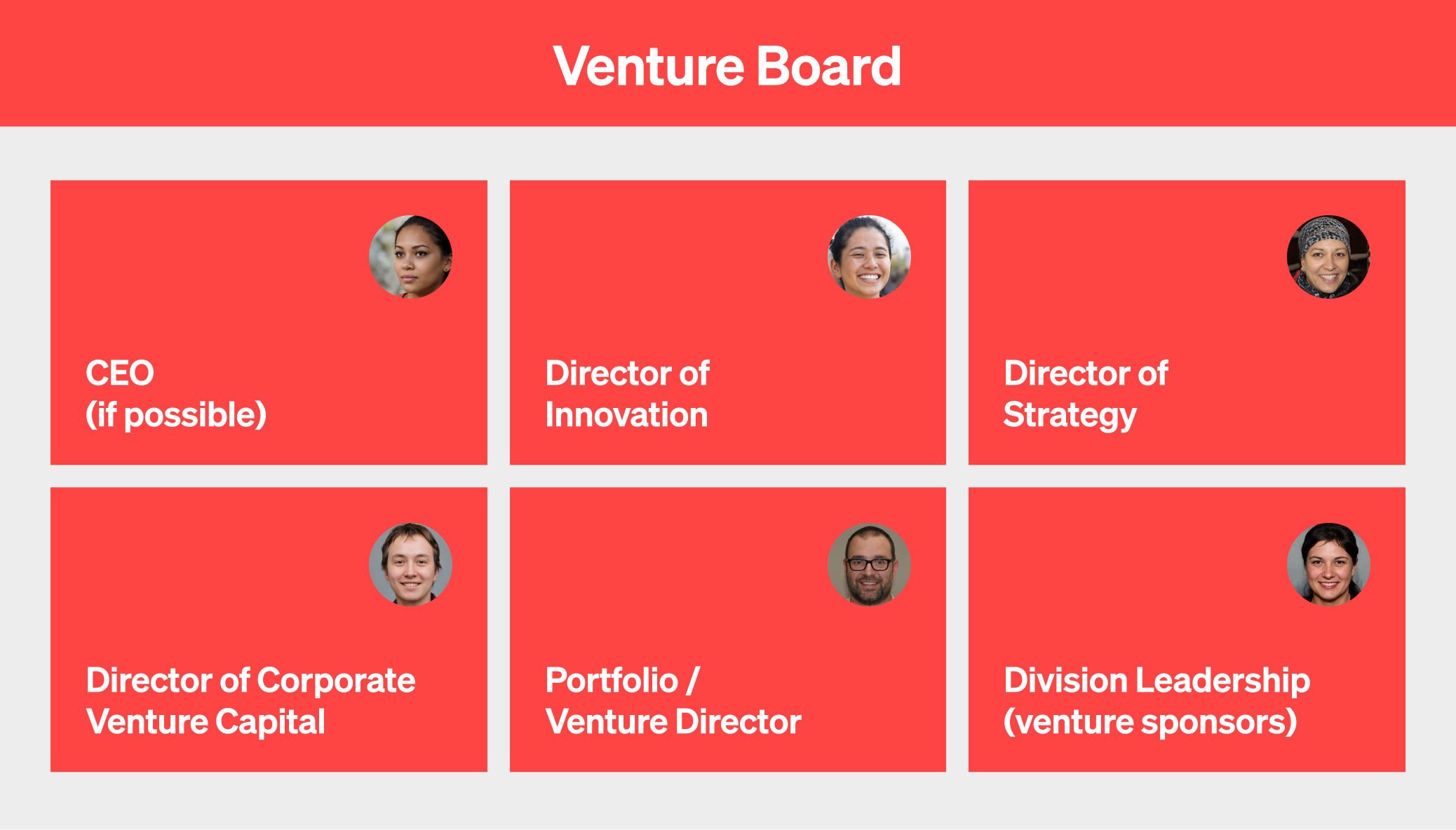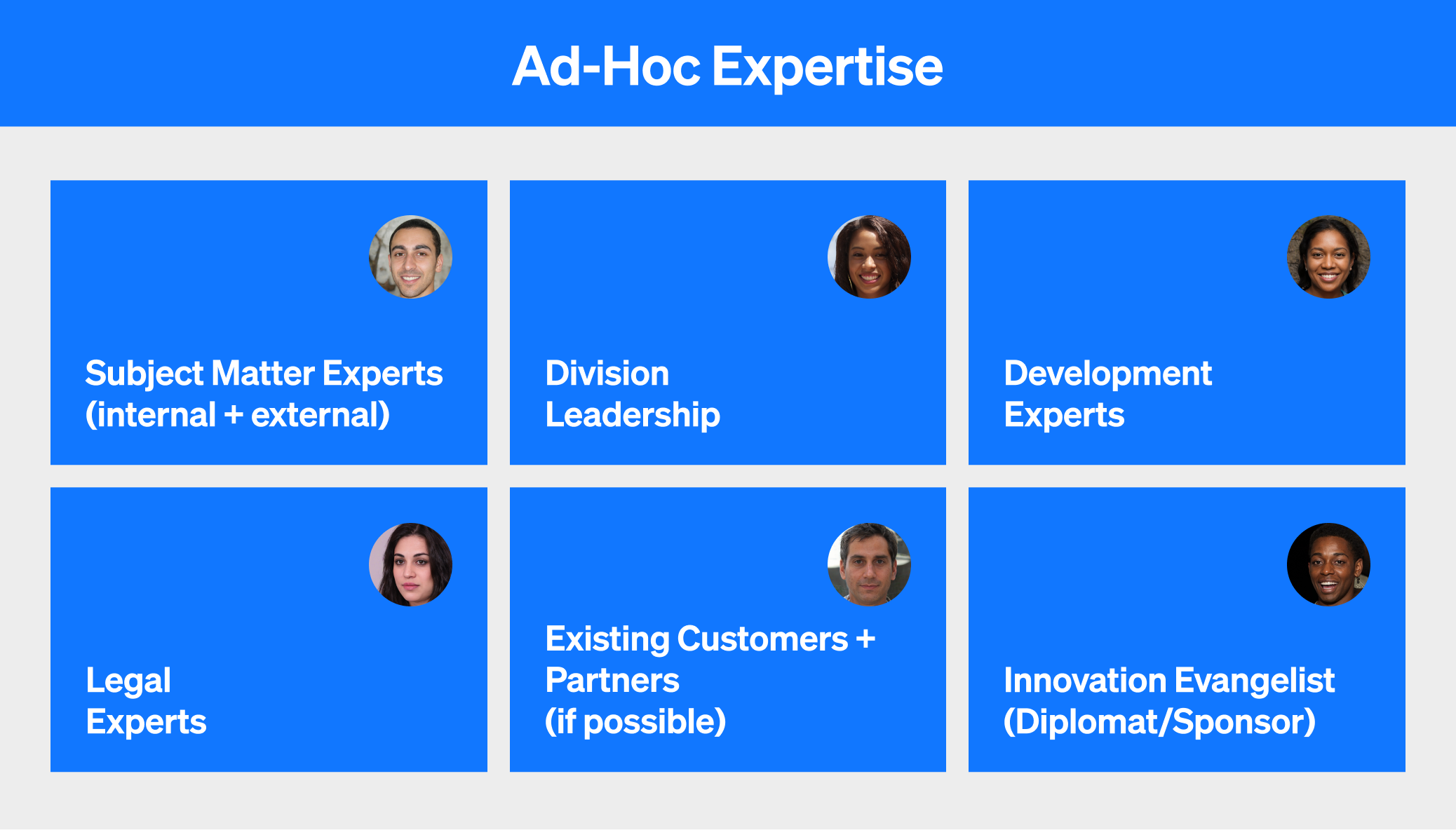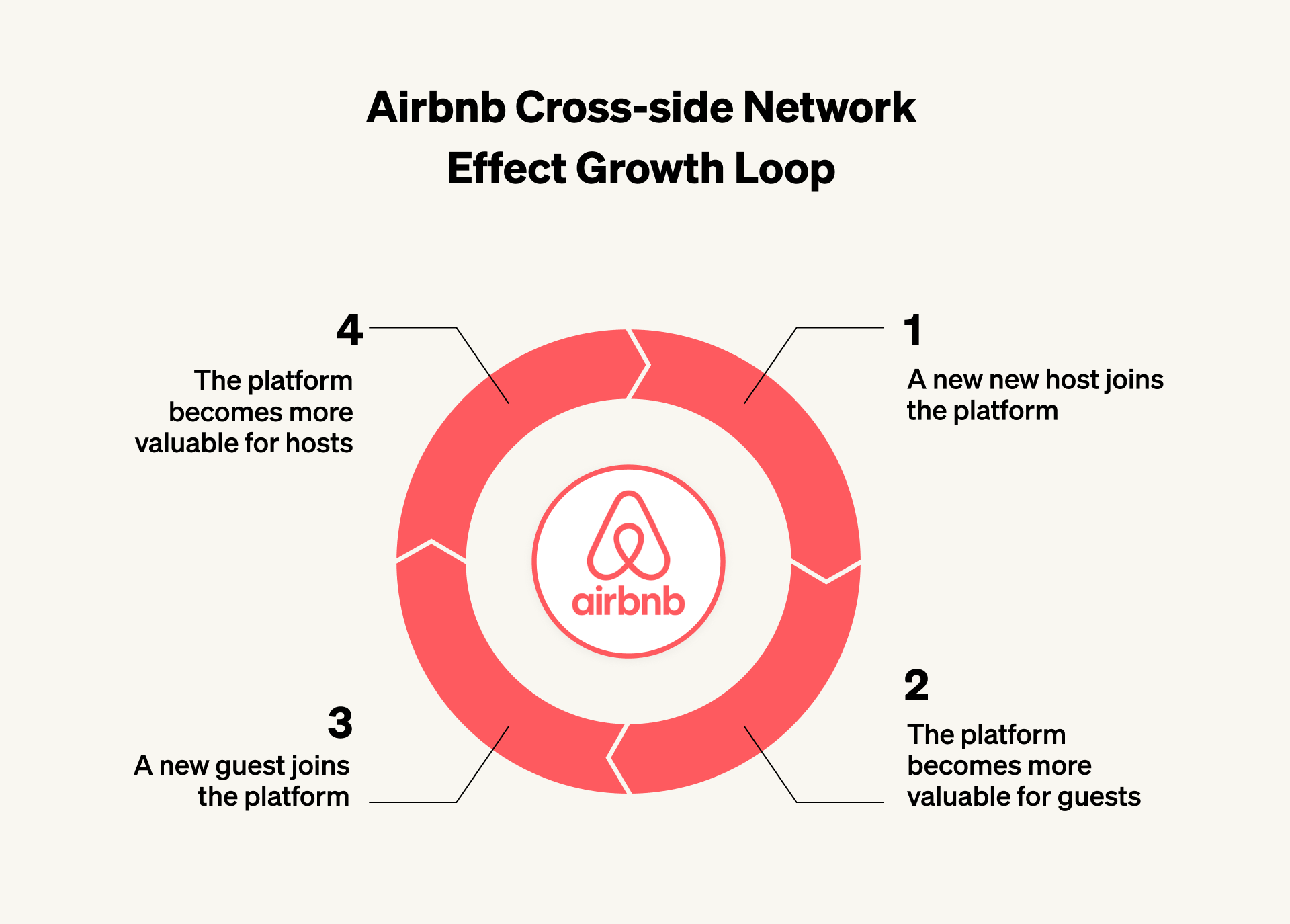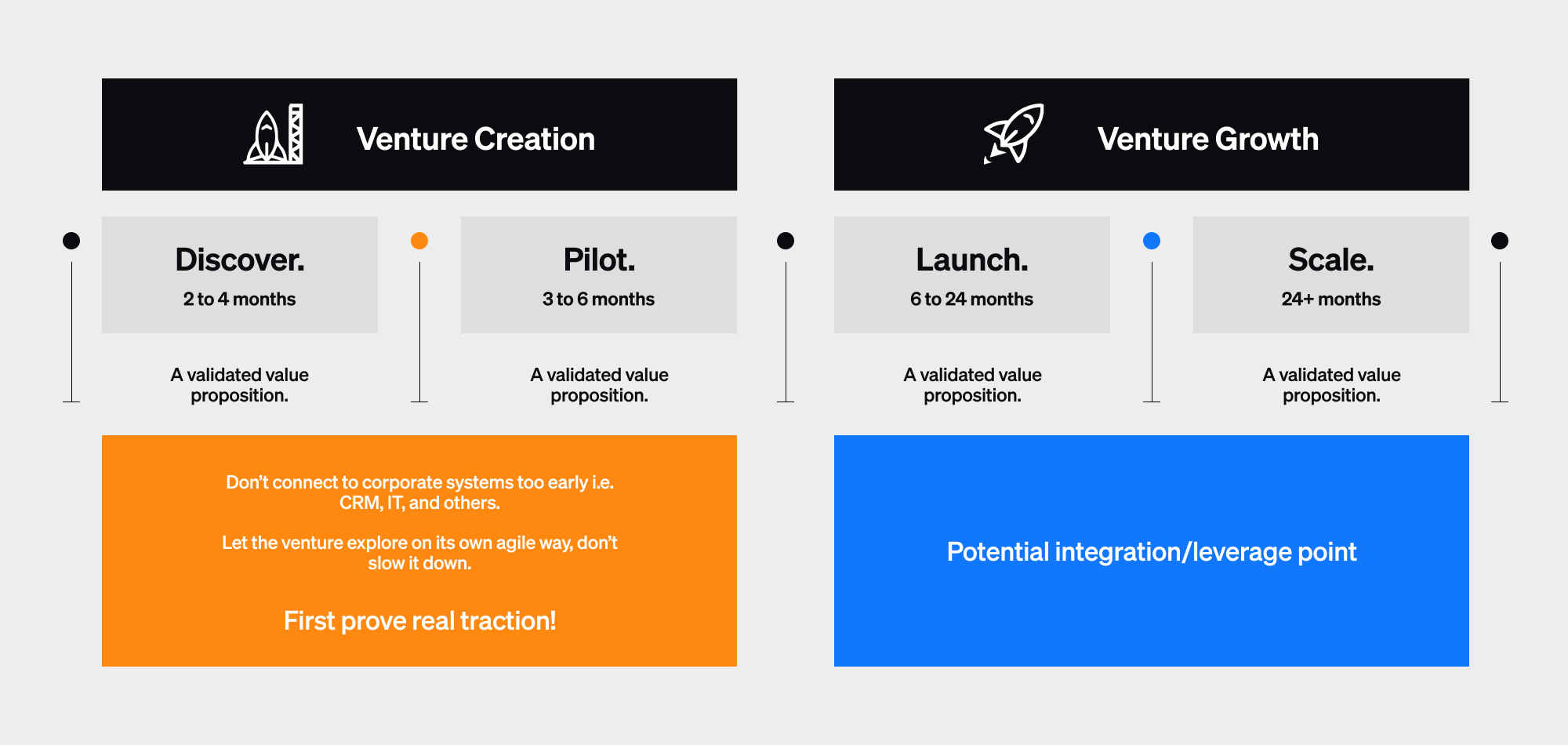Corporate venture scaling: an introduction
Bringing new ventures to life is an exhilarating process, but it’s no easy task. It requires tireless creativity, meticulous validation, and stellar pitching skills (just to name a few). All in the hopes of conquering that final growth milestone: The scale phase.
The problem is that too many corporate ventures end up failing to scale successfully:
- Only 22% of ventures launched in the past ten years have successfully scaled.
- 54% of executives believe scaling is the number one innovation problem.
- Only 10% of corporate digital innovation units manage to scale their ideas.
The good news is that by taking the right action at different critical stages in the lifecycle of your venture, you can mitigate the challenges, beat the odds and create a framework for long-term venture growth and profitability.
To help you achieve that goal, we’ve put together this comprehensive guide on corporate venture scaling, with actionable tips to help you accelerate your journey and avoid some of the common mistakes that might undermine your efforts.
Let’s kick things off with a bit of context.
Explore our global list of corporate ventures with over 200 examples you can sort by business model, industry, parent company and more!
What is a corporate scaleup?
Simply put, a corporate scaleup is a venture that has successfully hit its first few startup milestones. It’s primed for hyper-growth (e.g. higher customer acquisition and revenue) and has proven its viability by:
- Building and launching a minimum viable product (MVP)
- Establishing its product-market fit (PMF)
- Developing a business model that is both feasible and profitable
Part of the reason the scaleup phase is so important is because it marks the beginning of your venture becoming truly profitable. According to a study by McKinsey, about 66% of a venture’s value is created during that time.
For many intrapreneurs, this phase feels like a much-anticipated finish line - the ultimate success milestone. However, the truth is, that the real work is just beginning. During the scaleup phase, you’ll be tackling a whole new set of challenges, including growing your team, automating processes, refining your strategy and discovering new ways to establish your competitive edge.
In essence, you’ll be accelerating your venture’s growth exponentially, to meet the demands of your growing customer base. However, there’s a lot more to scaling than just growth
Growth vs scale: what’s the difference?
Making a clear distinction between growth and scale is vital in the context of building corporate ventures:
- Growth happens when a company increases its revenue while at the same time increasing its costs. For example, if your company gains a few new customers but has to increase its costs to keep up with the new demand, that would be considered growth.
- Scaling is when you increase your revenue exponentially with only an incremental increase in costs. For example, companies like Google have successfully grown their customer base while investing relatively few resources to accommodate them. In doing so, they were able to increase their profit margin quickly in just a few years. That’s how you scale.
Although both are good signs for your business, scaling is the way to go if you want to achieve long-term sustainability and profitability.
Examples of successful corporate scaleups
To give you a better idea of what corporate scaleups look like, here are 2 real-world examples:
Nøie
Nøie’s mission is to improve quality of life for people that suffer from skin issues. To do this, the scaleup offers products that are:
- Personalised and based on individual customer profiles
- Made with ingredients that are scientifically proven to help
One of the factors that make Nøie different from other skincare companies is that they’ve created communities or “skin families” of users with similar issues. Users get sorted into their skin family based on a detailed skin test algorithm that helps recommend customised products. These communities share their knowledge and experiences, adding to Nøie’s extensive database.
With about of all users reporting significant skin improvements, it’s clear Nøie has found a winning formula.

The scaleup journey
Born at LEO Pharma’s Innovation Lab in 2019, and co-founded by Daniel Jensen (CEO) and Chris Christianse (Chief Footprint Officer), Nøie has successfully scaled its team from 20 to 110 employees. During its scaleup phase, which started in 2020, the company was able to successfully reach many of its scaleup goals:
- Expanding to new European markets
- Launching new product categories (e.g. world’s first customised sunscreen)
- Becoming carbon-neutral (e.g. FSC certification, recyclable packaging)
Part of what made Nøie’s scaleup so successful was its “people-first” focus, which essentially means they prioritised people and culture during their scaleup phase. The process included carving out solid company values and building a team (e.g. hiring, training) based on those same values.
BOXLAB
Born in BASF’s business incubator, Chemovator, BOXLAB offers customers a fast and easy solution for replacing damaged labels and packaging in the chemical industry. The service can help companies that deal in highly regulated products save up to 90% in inventory that would otherwise be thrown away due to damaged packaging.
In 2020, BOXLAB became the first Chemovator company to spin-off and become its own independent entity. The process was led by founders and former Chemovator alumni Mischa Feig and Lisa Raschke. As explained by Feig:
“In order to create a comprehensive service, we offer complete system solutions as well as individual consulting for all matters concerning labelled packaging, labels and packaging materials.”

The scaleup journey
Since its foundation in 2020, BOXLAB has grown by leaps and bounds, scaling its services in a variety of ways, including:
- Offering Europe-wide deliveries within 24 hours
- Rolling out a new app for easy customer orders
- Placing high-value on sustainability
- Becoming an independent entity in 2021
Today, BOXLAB counts BASF as one of its biggest customers and boasts over 70 warehouses.
Why corporate ventures fail to scale and how to avoid it
The majority of ventures fail to make it passed the scale phase for a variety of reasons. Here are some of the most common:
- A lack of customer need
- Not validating early enough
- Not choosing the right success metrics
- The wrong entrepreneurial team
- An unstructured legal setup
In many cases, these barriers occur when the journey to scale is rushed, foregoing some of the crucial data-gathering actions needed to build a validated path forward. So how can you keep this from happening?
In our experience scaling corporate ventures, we’ve found that there are three critical actions that can set your corporate venture up for success on its journey to scale and beyond:
1. Define clear success metrics
The first step is to define and track your own unique success metrics. Avoid vanity metrics by focusing on core assumptions related to your finances, customer base, team and offering.
2. Recruit an effective venturing squad
The skillset needed to succeed during the startup phase differs from what you’ll need during the scaleup phase:
- Venture creation requires an in-depth knowledge of ideation, validation, and pivot methodologies.
- Venture growth requires an entrepreneurial, scaling mindset with domain expertise.
Therefore, an evolution in your team is required (we’ll talk more about this below).
3. Select a suitable entity format for your growth path
When choosing your entity format, there are two key questions you need to ask:
Each question should be asked at different points in the lifecycle of your venture as illustrated below:

Make sure to compare the pros and cons of each and use those insights to find the entity format that best fits your plans for the future.
How do you successfully scale a corporate venture?
We’ve already touched on some of the critical actions that can help propel your corporate venture forward during the scale phase. In this section, we’ll elaborate on the points above and provide some additional tips that can help you successfully scale your corporate venture:
Attract and recruit the right talent
As your venture evolves from startup to scaleup, so will your team. The first step to building your scaleup team will be to do an “inventory” to assess the skill gaps you have. This will enable you to pinpoint the profiles you’ll need to reach your long-term growth goals.
Once that’s done, you can move on to the hiring phase. Here are a few good tips to get you started:
- Hire people with an entrepreneurial mindset who have the vision, skills and motivation to make an impact and get things done.
- Get to know your candidates by encouraging them to present their multi-year vision and strategy during the recruitment process.
- Make sure your job description features your venture’s long-term goals and ambitions. This will help you attract entrepreneurs that share your vision.
We’ll go into more detail on how to build your scaleup team later on in this article.
Build strategic partnerships
During the scale phase, it should always be a priority to grow your internal resources. Having said that, there are some instances when recruitment just isn’t the answer. In some cases, outsourcing can free you and your team to focus on the bigger picture (i.e. growing your business) instead of getting caught up in day-to-day matters.
Collaborate and build strategic partnerships with entrepreneurs and organisations that can help take your business forward (e.g. sales partners, service providers, suppliers, PR experts, etc.). These alliances can help strengthen your venture and facilitate the long-term success of your scale efforts.
Validate your strategy
The scaling phase is a good time to revisit, reassess and validate your business case. Validation before any big move is always beneficial because it can help you identify and address any weaknesses early on. An excellent way to start is by gathering the key learnings and insights gained during your alpha launch and using them as a baseline business case to work from.
Make sure it includes:
- Any scaleup targets you had already established in previous phases.
- New venture horizons you might be interested in (e.g. new locations, premium offerings, new target groups, etc.).
- Any changes to your business model that have been made along the way.
Once that’s done, you can use several lean validation techniques (e.g. smoke testing, online surveys, personal interviews etc.) to identify any weak points and get real customer data on your scaleup strategy.
Automate your processes
When it comes to scaling a venture, automation is a surefire way to get things done quicker, easier and for a lot less money. The trick is not only to identify the IT solutions you need but to find a way to integrate them to keep things running smoothly and efficiently.
Here are just a few of the processes you should consider automating for the scale phase:
- Marketing: Encourage your marketing team to use digital marketing tools and growth hacking techniques to create successful campaigns that can be replicated in the future.
- Customer Relationship Management (CRM): Finding the right CRM system can help you get the most out of your customer data and increase the collaboration between your sales and marketing teams.
- Finance and accounting: Automation in this area will enable you to access detailed and accurate financial data to make pivotal decisions at every step of the scale phase.
- Human resources: Finding the right HRMS will enable you to manage your team more effectively, track KPIs and speed up time-consuming tasks that would otherwise be done manually.
Define your competitive edge
A crucial part of successfully scaling your business is understanding the factors that give you a leg up over the competition. Most of the work in this area is done during the startup phase.
For example, let’s say your core business is selling indoor plants online, but during your startup phase, you discover that your offering is wildly popular with businesses (as opposed to individuals looking for house plants). In such a case, you might want to consider specialising in plants for offices to play on your strengths during the scaleup phase.
How to build a team for your new corporate scaleup
Now that we’ve covered the basics, let's take a look at some of the factors you should consider when building your corporate scaleup team.
To succeed in the long-term, you’ll need to leverage the talent and expertise of creatives, entrepreneurs, stakeholders and even some external partners along the way. In essence, you’ll need to create a multi-team setup that consists of:
A venture board
Venture boards are made up of corporate sponsors that are uniquely positioned to provide valuable strategic advice.

They usually meet with venture teams on a quarterly or monthly basis to provide guidance and help keep the venture aligned with the broader corporate agenda. This in turn will increase the venture’s chances of:
- Getting the funding and resources needed to move forward
- Keeping the strategy and KPIs on track
- Making decisions with the full support of the mothership
In short, venture boards act as an added support layer around the team — linking the venture to the parent company and helping them leverage corporate assets quickly and efficiently.
An internal team
The role of the internal team is mainly to take ownership of different parts of the venture, including quality, strategy, recruitment, the roadmap and the execution of various tasks. Profiles that are typically included in an internal team include:

In some cases, they can take on a targeted leadership role with titles like venture lead, product lead or marketing lead. As the name suggests, these profiles make key decisions in specific areas helping to guide the venture team as they execute various tasks.
A venture team
Venture teams take charge of the everyday execution of various tasks under the guidance of the venture board and the internal team. The tricky part is, you’ll need two separate venture teams, one for the venture creation phase and one for the venture growth phase.
For example, during the first few months of building a new venture, your focus will be to bring your new concept to life (i.e. venture creation). This will most likely involve building an MVP, identifying your target audience and creating your first marketing campaigns. You’ll need a team that’s creative, loves to ideate and knows how to effectively validate new value propositions.
Now, fast forward to the venture growth stage, when you’ve proven your product-market fit and are ready to take your venture to the next level. At that point, you’ll need an extra boost of entrepreneurship, ready to take charge during your launch and scale phases. These are profiles with experience in venture growth that can hit the ground running and take ownership of the venture’s strategy, finances and growth milestones moving forward.
.png)
These profiles are best hired once you found your product-market fit and the direction of the venture is set. That’s when it’s time to tap them in and let them unleash their entrepreneurial talents to scale the venture and make real business impact.
Ad-hoc expertise
Ad-hoc experts are external partners that can step in and provide support in any areas you might be lacking. Here are just a few examples:

Ad hoc experts can be brought in to do anything from building a new PR campaign, to app development, to helping your team create a new algorithm from scratch. Although they’re only with you for part of the journey, their contributions can play an essential role in the long-term success of your venture.
How to build a scaleup marketing strategy
A huge part of your efforts during the scale phase will go into building your new scaleup marketing strategy. In most cases, this will require a marketing reboot, complete with testing and quite a few iterations, before you find your sweet spot. To give you a better idea of how to create a marketing strategy for your scaleup, we’ve provided some key tips below.
Tip 1. Align your marketing efforts with your expansion strategy
International expansion to new markets is a common ambition among corporate scaleups. However, this type of expansion can be challenging with many variables impacting your marketing efforts:
- Cultural differences from country to country
- Legal and governmental requirements
- Disparate time zones
- Physical distance and its impact on logistics
Make sure to keep in mind that with every country you add, your marketing efforts will need to increase exponentially. Your budget and operational speed will take a hit in the beginning.
At Bundl, we’re not a fan of “oil spill expansion”. Instead, we recommend a springboard approach in which you start with one country, build your presence there and only then start to expand to neighbouring countries. This continues until you’ve covered the entire continent and are ready to grow beyond.
Tip 2. Implement growth loops instead of funnels
Despite their popularity, funnels come short in a variety of ways:
The approach is siloed
Funnels tend to encourage separate responsibilities for different departments (e.g. marketing is in charge of acquisition, sales is in charge of revenue and product development is in charge of retention). This can inhibit collaboration and broader wins.
They’re hard and expensive to maintain
In order to succeed, funnels constantly need to be fed with new inputs, which need to be acquired through paid ads, new content and social media activities. All costly and time-consuming activities that add to your customer acquisition costs.
Growth is linear
Funnels require a steady flow of inputs and produce linear growth. This pays off in the short-term, but eventually puts a cap on your long-term growth.
In contrast, growth loops foster organic, exponential growth by “looping” your outputs (normally discarded in a funnel) back in with your inputs. To show you how growth loops work in practice, let's take a look at a real-world example from Airbnb:

Some of the benefits of using loops include:
- Better cross-departmental collaboration
- More sustainable and organic growth
- They tend to be unique to your business, making it harder for competitors to copy them
Tip 3. Bring in the right talent
Now that your venture is about to scale, it’s a good time to start building up your internal capabilities with complementary team members. Look for profiles with expertise in areas like SEO, paid acquisitions and content marketing. Adding these valuable skills to your team will enable you to optimise all the winning experiments from previous phases and build on them during the scale phase.
A good place to start is by hiring your chief marketing officer (CMO). Once he or she is on board, you can proceed to hire the rest of the marketing team together. By having your new CMO approve all new team members, you’ll ensure a more streamlined and cohesive team environment.
Tip 4. Focus on customer experience
Here are just a few ways you can use marketing to enrich your customer experience:
- Engage your customers by becoming a thought leader
- “How to” articles
- Video tutorials
- Case studies and examples that engage
- Leverage social media to create a sense of community and customer loyalty
- Engage your customers by staying active in various channels
- Always respond to your customer questions and comments
- Create a convenient onboarding experience
- Automate the onboarding process where possible
- Make sure all information is available, quickly accessible and easy to consume
- Make sure your values and messaging is consistent
- In ads
- Physical stores
- Social media channels
- Your website
Tip 5. Keep testing, measuring and learning
Much like the startup phase, your chances of scaleup success will be greatly increased through continuous validation and data-led decisions. Here are a few things you can expect:
- Your paid acquisition costs will increase during the scaleup phase. So optimising your channels, bringing in new experts and refining your campaigns will be worth it.
- Proven tactics from previous phases are a good way to forecast your KPIs (If you don’t have any proven tactics yet, you’re not ready to scale). Your stakeholders and investors will thank you for making accurate predictions based on past successes.
- During the scale phase, you’ll be growing your team, which will result in an influx of new personalities. In most cases, this will require you and your team to overcome a variety of new operational challenges. Be ready for it.
- Be patient with your new experiments. They’ll work fine in the beginning, but in most cases will only reach their full potential later (after a few weeks of tweaking).
How to measure the success of your corporate scaleup
During the scaleup phase, the right success metrics can help you:
- Move forward with confidence based on data-fueled decisions
- Guide your resource allocation
- Trigger behavioural changes that get you closer to your goals
- Set benchmarks for the future
When defining which success metrics to use for your corporate scaleup, it is important to consider two things:
- Commonly used metrics don’t tell the entire venture story
- There is no one-size-fits-all set of metrics, even between ventures
To get a more accurate picture of your scaleup’s performance, we recommend using the NICE framework - a comprehensive metrics set created with the help of innovation experts from the Bundl Venture Club.

Here’s a quick breakdown of how NICE framework works:
Non-financial metrics
Most stakeholders use financial metrics because they are unambiguous, readily available, and widely understood within most organisations. But overemphasising them as the core measure of success misdirects attention away from other values gained from innovation activities.
Examples of non-financial metrics include:
Implementable metrics
Innovators need to track metrics that support decision-making. But finding these metrics means prioritising executable metrics rather than vanity metrics.
Examples of implementable metrics include:
Contextual metrics
When choosing which metrics can accurately predict success, you need to take into account different contextual factors (e.g. whether your venture is a startup or scaleup, a B2B or a B2C, who your target audience is, etc.). This will help you get more accurate results.
Examples of contextual metrics include:
Evolving metrics
Measuring innovation isn’t a static process. It must evolve with the innovative competencies of an organisation. A set of metrics should be built step-by-step as the innovation expertise in the organisation grows.
Examples of evolving metrics include:

To help you map out your own NICE metric set, we designed this handy interactive canvas.
Insights from the author of “Lean Scaleup” Frank Mattes
We caught up with Frank Mattes, founder of innovation-3 and author of “Lean Startup”, to get his expert advice on how to successfully scale corporate ventures. Discover all the insights he shared with us by watching the interview below.
The next steps
There’s no one secret to successfully scaling a venture. It’s a long process that takes commitment, attention to detail and, above all else, constant testing and validation from start to finish. Follow these 4 golden rules for scaling when taking those next steps:
Rule 1. Kill or pivot fast and early, based on data.
Rule 2. Stay connected to the broader corporate strategy
Rule 3. Do not skip the pilot (i.e. MVP phase)!
Rule 4. Time your integration and leverage your assets wisely

Following the four rules described above can help you avoid some of the pitfalls commonly responsible for taking down promising ventures during their scale phase. Providing you with a solid, data-driven and user-tested foundation strong enough to take you beyond the scale phase and - enabling you to make real business impact.
Check out our hsbcad case study to find out how Bundl can help you successfully scale your corporate venture.
_________
Are you Looking to take your corporate venture to the next level? We can help you build a detailed, measurable, and automated scaleup strategy to boost profits at light speed.







